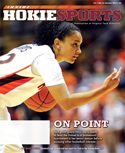Nick Acree was the rage this past August in Tech preseason practices largely because few in these parts had seen a freshman the size of Acree.
He came in at 6-foot-5 and weighed a hulking 315 pounds, and he shattered a freshman record when he threw up 450 pounds in the bench press. Unpolished technique and rust from not having played in more than a year – he tore his ACL and missed the 2009 season at Fork Union – resulted in him redshirting in his first season at Tech.
The result? A new man.
Acree, a defensive tackle from King William, Va., who signed with Tech this past February, used the redshirt year to shed more than 20 pounds and get his body fat down to 17 percent.
“Coach [Mike] Gentry has gotten me back to where I need to be,” Acree said. “I’ve dropped fat. My body fat is now down thanks to him. I’m ready to learn a lot this spring and summer. I need to keep learning.”
Acree is one of 14 freshmen to redshirt this past season out of the 20 who signed with the Hokies this past February. Two of those 20 did not enroll (DeAntre Rhodes and Tahrick Peak), two deferred enrollment to January (Caleb Farris and Justin Taylor), and only two played. Both cornerback Kyle Fuller and defensive tackle Derrick Hopkins saw extensive time this season.
| Recruiting class |
No. of those who played as true freshmen |
| 2010 | 2 (Kyle Fuller, Derrick Hopkins) |
| 2009 | 3 (David Wilson, D.J. Coles, Jayron Hosley) |
| 2008 | 6 (Jarrett Boykin, Jake Johnson, Quillie Odom, Dyrell Roberts, Eddie Whitley, Lorenzo Williams) |
| 2007 | 3 (Tyrod Taylor, Chris Drager, Davon Morgan) |
Tech’s coaching staff goes into 2011 spring practice expecting big things from the 2010 recruiting class, especially among its defensive players. The Hokies allowed nearly five yards per carry in 2010, so getting bigger and more physical up front stands as a priority.
That means a guy like Acree and fellow defensive lineman Zack McCray will have an opportunity. Acree has been mentioned as a possible offensive lineman, but rest assured, Tech’s staff wants to give him every shot at becoming a stalwart on the defensive front.
“I’m not sure,” Acree said of his future position. “It’s all debatable. But in talking to the coaches, I’m making good progress and that’s all I can ask for. I just want to get better each time.
“I don’t have a preference. Wherever they need me, that’s where I’ll play. I just want to be the best at whatever position they put me at.”
As for McCray, the defensive end from Lynchburg, Va., came to Tech weighing about 235, but now weighs 253 and got a lot stronger while redshirting.
“Coming in, you always want to compete and get some early playing time,” said McCray, arguably Tech’s highest-rated recruit in the 2010 class. “But I definitely think it’s [redshirting] been the best for me. I’ve put some weight on and gotten bigger stronger and faster. I’ve learned the whole system and what I need to do to come in and compete next year. So it’s been a big help.”
Tech’s staff also expects a few other freshmen to compete for playing time, including 6-1, 190-pound Nick Dew from Virginia Beach, Va., at the rover spot, where the Hokies lose All-ACC performer Davon Morgan, and Detrick Bonner, a 6-0, 180-pounder from McDonough, Ga., at the cornerback position, where the Hokies lose standout Rashad Carmichael. Also, the coaches like Dominique Patterson, a linebacker from Suffolk, Va. He weighed in recently at 227 pounds and may end up moving to a linebacker spot. Brian Laiti, a 6-3, 210-pounder from Fairfax Station, Va., also projects as a linebacker.
On offense, most of the freshmen who redshirted will find it tough to get playing time in 2011. That’s because the Hokies return the core of their offense – they lose just four starters (Tyrod Taylor, Andre Smith, Darren Evans and Beau Warren).
Smith may be the hardest to replace because only one other tight end saw extensive action at the spot this past season (Eric Martin). That means an opportunity is there for Jerome Lewis, a 6-3, 247-pounder from New York who redshirted.
He will be scrutinized closely this spring, along with the two quarterbacks in this class – Mark Leal, a 6-0, 200-pounder from Greenacres, Fla., and Ricardo Young, a 6-0, 160-pounder from Washington, D.C. Those two possess the talent to be a back-up behind projected starter Logan Thomas, but need to show they can grasp the offense to edge current projected No. 2 Ju-Ju Clayton.
Receiver E.L. Smiling, a 6-3, 200-pounder from Stafford, Va., and linemen Mark Shuman, a 6-7, 310-pounder from Fork Union, Va.; Matt Arkema, a 6-3, 275-pounder from Midlothian, Va.; and Laurence Gibson, a 6-5, 293-pounder from Sierra Vista, Ariz., also find themselves in similar situations. The coaching staff loves their potential, but their future may not be next season because of the talent and experience in front of them at their positions.
After spending the fall on the scout team, the majority agreed that redshirting was in their best interests. Certainly, it allows players to get bigger and stronger and adjust to college life. But more importantly, they get used to the speed of the game, which is the biggest adjustment for incoming freshmen.
“You definitely need the year to sit out and prepare for it because the speed of the game is something that changes just like that,” McCray said, snapping his fingers. “Everyone said the speed of the game was different. But you’ve got to be here to experience it in order to believe it.”
They experienced it this past fall. They’ll get to experience it again this spring.
And their performance on the field will tell just how much they’ve adapted after redshirting this past fall.




